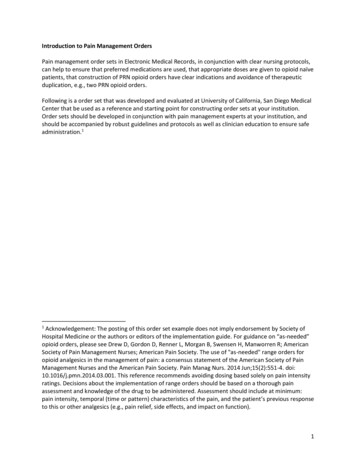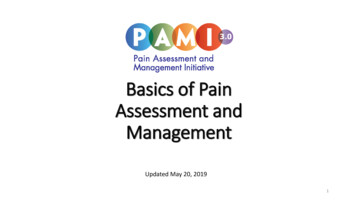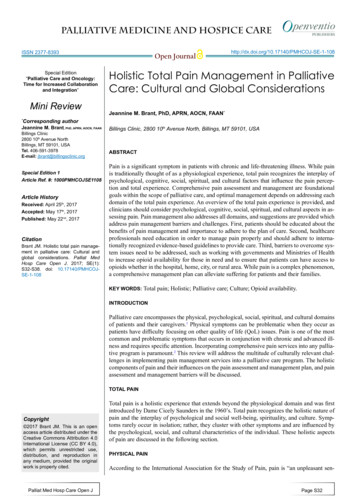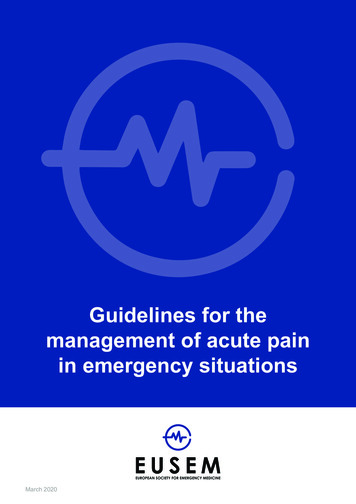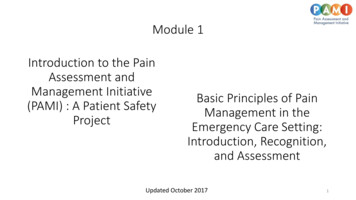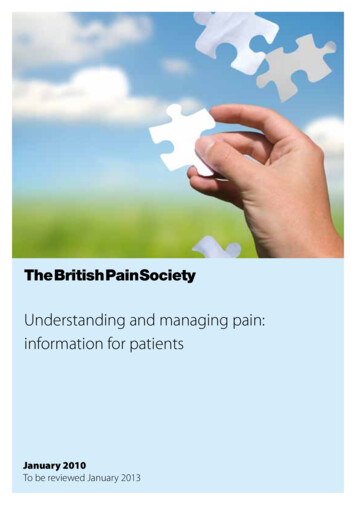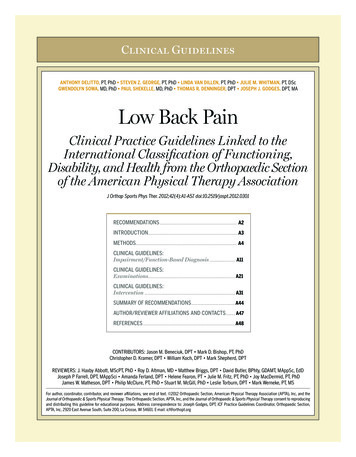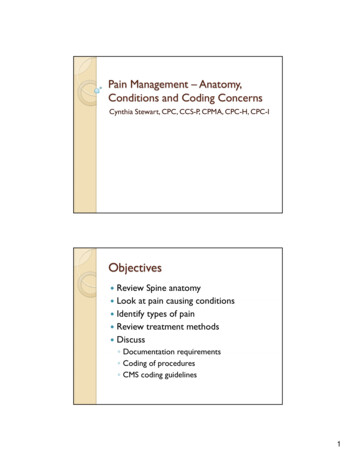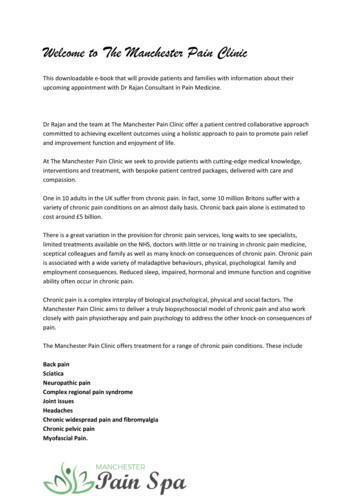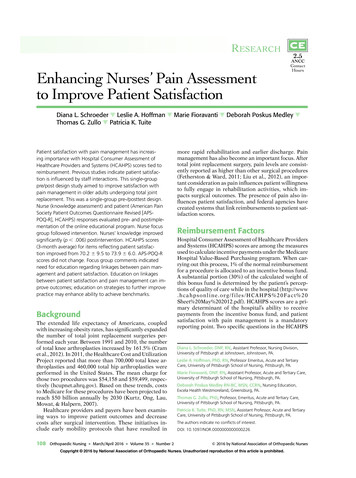
Transcription
RESEARCHEnhancing Nurses’ Pain Assessmentto Improve Patient Satisfaction2.5ANCCContactHoursDiana L. Schroeder Leslie A. Hoffman Marie Fioravanti Deborah Poskus Medley Thomas G. Zullo Patricia K. TuitePatient satisfaction with pain management has increasing importance with Hospital Consumer Assessment ofHealthcare Providers and Systems (HCAHPS) scores tied toreimbursement. Previous studies indicate patient satisfaction is influenced by staff interactions. This single-grouppre/post design study aimed to improve satisfaction withpain management in older adults undergoing total jointreplacement. This was a single-group pre-/posttest design.Nurse (knowledge assessment) and patient (American PainSociety Patient Outcomes Questionnaire Revised [APSPOQ-R], HCAHPS) responses evaluated pre- and postimplementation of the online educational program. Nurse focusgroup followed intervention. Nurses’ knowledge improvedsignificantly (p .006) postintervention. HCAHPS scores(3-month average) for items reflecting patient satisfaction improved from 70.2 9.5 to 73.9 6.0. APS-POQ-Rscores did not change. Focus group comments indicatedneed for education regarding linkages between pain management and patient satisfaction. Education on linkagesbetween patient satisfaction and pain management can improve outcomes; education on strategies to further improvepractice may enhance ability to achieve benchmarks.BackgroundThe extended life expectancy of Americans, coupledwith increasing obesity rates, has significantly expandedthe number of total joint replacement surgeries performed each year. Between 1991 and 2010, the numberof total knee arthroplasties increased by 161.5% (Cramet al., 2012). In 2011, the Healthcare Cost and UtilizationProject reported that more than 700,000 total knee arthroplasties and 460,000 total hip arthroplasties wereperformed in the United States. The mean charge forthose two procedures was 54,158 and 59,499, respectively (hcupnet.ahrq.gov). Based on these trends, coststo Medicare for these procedures have been projected toreach 50 billion annually by 2030 (Kurtz, Ong, Lau,Mowat, & Halpern, 2007).Healthcare providers and payers have been examining ways to improve patient outcomes and decreasecosts after surgical intervention. These initiatives include early mobility protocols that have resulted in108Orthopaedic Nursing March/April 2016 Volume 35 Number 2more rapid rehabilitation and earlier discharge. Painmanagement has also become an important focus. Aftertotal joint replacement surgery, pain levels are consistently reported as higher than other surgical procedures(Fetherston & Ward, 2011; Liu et al., 2012), an important consideration as pain influences patient willingnessto fully engage in rehabilitation activities, which impacts surgical outcomes. The presence of pain also influences patient satisfaction, and federal agencies havecreated systems that link reimbursements to patient satisfaction scores.Reimbursement FactorsHospital Consumer Assessment of Healthcare Providersand Systems (HCAHPS) scores are among the measuresused to calculate incentive payments under the MedicareHospital Value-Based Purchasing program. When carrying out this process, 1% of the normal reimbursementfor a procedure is allocated to an incentive bonus fund.A substantial portion (30%) of the calculated weight ofthis bonus fund is determined by the patient’s perceptions of quality of care while in the hospital 0Sheet%20May%202012.pdf). HCAHPS scores are a primary determinant of the hospital’s ability to receivepayments from the incentive bonus fund, and patientsatisfaction with pain management is a mandatoryreporting point. Two specific questions in the HCAHPSDiana L. Schroeder, DNP, RN, Assistant Professor, Nursing Division,University of Pittsburgh at Johnstown, Johnstown, PA.Leslie A. Hoffman, PhD, RN, Professor Emeritus, Acute and TertiaryCare, University of Pittsburgh School of Nursing, Pittsburgh, PA.Marie Fioravanti, DNP, RN, Assistant Professor, Acute and Tertiary Care,University of Pittsburgh School of Nursing, Pittsburgh, PA.Deborah Poskus Medley RN-BC, MSN, CCRN, Nursing Education,Excela Health Westmoreland, Greensburg, PA.Thomas G. Zullo, PhD, Professor, Emeritus, Acute and Tertiary Care,University of Pittsburgh School of Nursing, Pittsburgh, PA.Patricia K. Tuite, PhD, RN, MSN, Assistant Professor, Acute and TertiaryCare, University of Pittsburgh School of Nursing, Pittsburgh, PA.The authors indicate no conflicts of interest.DOI: 10.1097/NOR.0000000000000226 2016 by National Association of Orthopaedic NursesCopyright 2016 by National Association of Orthopaedic Nurses. Unauthorized reproduction of this article is prohibited.ONJ766.indd 10817/03/16 1:46 PM
survey address pain management and patient satisfaction: “During this hospital stay how often was yourpain well controlled?” (Q13) and “How often did thehospital staff do everything they could to help you withyour pain?” (Q14).These reporting requirements establish an importantlinkage. Early initiation of mobility and rehabilitationservices has resulted in decreased length of stay andcost reductions in patient care, thereby meeting thegoals of the payers. However, in order to carry out therequired mobility regimen, patients need to have theirpain effectively managed. Without this advantage, postoperative recovery and patient satisfaction may be compromised. Reimbursements tied to patient satisfactiontherefore incentivize providers to improve pain management and patient satisfaction.Pain and Patient SatisfactionPrior studies suggest that patient satisfaction with painmanagement is influenced by a number of factors, including personal beliefs, expectations, and interactionswith healthcare providers (Chow, Mayer, Darzi, &Athanasiou, 2009; Liu et al., 2012; Niemi-Murola et al.,2007; Wadensten, Frojd, Swenne, Gordh, &Gunningberg, 2011). Patients who undergo joint replacement procedures are typically older than 65 yearsand often have differing perceptions of pain comparedto younger patients, including whether pain should beaccepted and/or tolerated (Alm & Norbergh, 2013;Hadjistavropoulos et al., 2007; Herr, 2011, Prowse,2007). Older adults tend to be more concerned aboutbecoming addicted or impaired due to opiate use compared to younger patients (Dunwoody, Krenzischek,Pasero, Rathmell, & Polamano, 2008). Regardless ofage, pain associated with total joint replacement is oftengreater than expected, an outcome that has been identified as a possible contributing factor to decreased patient satisfaction with pain management in patients undergoing joint replacement (Pulido, Hardwick, Munro,May, & Dupies-Rosa, 2010).Pain AssessmentBecause nursing care has a central role in ensuring optimal pain management and patient satisfaction withpain management, these factors create an important opportunity for nursing. Ineffective pain management influences patient recovery. Ineffective pain managementmay also impact the organization as a consequence ofincreased readmissions, prolonged length of stay, andpoor clinical outcomes (Dunwoody et al., 2008;Gillaspie, 2010; Gupta, Daigle, Mojica, & Hurley, 2009).Innis, Bikaunieks, Petryshen, Zellermeyer, and Ciccarelli(2004) maintain that the “most common barrier to successful pain management is the failure to assess. That is,clinicians may not inquire about the presence of pain.”(p. 322). Jamison et al. (1997), early investigators of therelationship between pain management and patient satisfaction, noted that although patients who experiencedlower pain ratings were most satisfied with their 2016 by National Association of Orthopaedic Nursespostoperative care, those who experienced less painthan expected had higher satisfaction with their overallcare. They further note that patients who perceive theircare providers to be concerned with their pain levels reported greater satisfaction with their care. Hanna,González-Fernández, Barrett, Williams, and Pronovost(2012) contributed to this insight by reporting that patient satisfaction does not correlate strongly with painintensity but, rather, patient satisfaction is more dependent on how the patient perceives that caregiversrespond to their pain.Findings of these and other studies support the concept that improving patient satisfaction with pain management can be achieved by greater collaboration andcommunication with the patient regarding their painstatus and the effect of pain interventions (Chow et al.,2009; Gordon, Dahl, & Stevenson, 2000; Innis et al.,2004; JCAHO, 2000; Quinlan-Colwell, 2009; Wadenstenet al., 2011). Improved pain assessment and communication can assist in reaching the goal of improving patient satisfaction.Improving Patient SatisfactionIn 2013, the project site for this study identified a decline in patient satisfaction with pain managementbased on HCAHPS survey results and, more specifically,among patients admitted for orthopaedic total joint surgery. This decline appeared to be linked to responses topain management questions. This finding prompted asearch for ways to improve pain management andpatient satisfaction by improving the nursing careprovided.We therefore initiated a quality improvement projectto improve the nurse’s assessment of a patient’s pain inthe postoperative total joint patient population with theend objective of improving patient satisfaction with painmanagement. The specific aims of the project were to:1. Develop an online educational tool to instructnurses in use of an expanded pain assessmentprotocol specific to joint replacement surgicalpatients that incorporated pain assessmentrelative to mobility and specifically addressedpain management concerns of older adults.2. Evaluate change in nurses’ knowledge pre- andpostintervention related to pain assessment injoint replacement surgical patients and strategies to improve patient satisfaction with painmanagement.3. Evaluate patient satisfaction with pain management after implementation of the instructional project.MethodsDESIGNThis quality improvement project utilized a singlegroup pre-/posttest design. Approval was obtained fromthe Exempt Institutional Review Board at the healthcare system.Orthopaedic Nursing March/April 2016 Volume 35 Number 2 109Copyright 2016 by National Association of Orthopaedic Nurses. Unauthorized reproduction of this article is prohibited.ONJ766.indd 10917/03/16 1:46 PM
SETTING AND SAMPLEThe project was initiated on the 15-bed orthopaedic unitof a 325-bed community hospital located in southwestern Pennsylvania. An average of 75 joint replacementsurgeries are performed each month in this facility. Allregistered nurses (n 30) assigned to the orthopaedicunit were encouraged to participate in the online education course. Patients were included in the study if theywere admitted to the orthopaedic unit and underwenttotal joint replacement surgery. Patients were excludedif they were scheduled for a revision arthroplasty (morecomplex procedure), unable/unwilling to complete thesurvey independently (not primary data source), or didnot speak English (questionnaires in English).Project ImplementationFIGURE 1. Summary of eight steps to enhanced pain assess-The project was conducted in four steps.ment from evidence-based guidelines.PHASE 1Before instruction of nursing staff, the American PainSociety Patient Outcomes Questionnaire Revised(APS-POQ-R) was given to 100 patients who had totaljoint replacement (Gordon et al., 2010). Questionnaireswere distributed over a 3-month period and used to establish baseline patient satisfaction scores. In addition,HCAHPS scores for the two previously identified questions that focused on pain management were retrievedfrom the hospital database for the same 3-month period. These questions were as follows: “During this hospital stay how often was your pain well controlled?”(Q13) and “How often did the hospital staff do everything they could to help you with your pain?” (Q14).PHASE 2To provide staff nurse education, an online learningmodule was developed that summarized evidence-basedliterature regarding enhanced pain assessment in thepostoperative total joint patient. Three major areas ofassessment were addressed including current best practices in postoperative pain management in the totaljoint population, considerations in pain assessment inthe older adult patient, and specific strategies that enhance patient satisfaction. The module introduced eightsteps identified from the literature to ensure enhancedpain assessment. In addition, laminated posters wereplaced on portable computer modules used for chartingand medication administration as reminders. Eachnurse also received a pocket-sized laminated card withthe 8 steps to assist them in implementing changes tothe pain assessment protocol (see Figure 1). To assesschanges in knowledge, nursing staff were asked to anonymously complete a researcher-compiled pre and posttest. The posttest content was identical to the pretest.This phase of the study was conducted over 2 weeks.PHASE 3After 80% of nursing staff on the unit had completed themodule, patient satisfaction with pain management wasassessed by again administering the APS-POQ-R to100 patients on the selected unit to determine110Orthopaedic Nursing March/April 2016 Volume 35 Number 2postimplementation patient satisfaction with pain management. This phase of the study was conducted over 3months. HCAHPS scores were retrieved from the hospital database for the two previously identified questionsthat focused on pain management for the same 3-monthperiod.PHASE 4At the conclusion of data collection, a focus group washeld with six nursing staff participants to determineperceptions of changes in pain assessment on their unit,satisfaction with the implementation process and suggested modifications. These six participants were nursesfrom the unit who volunteered to participate.InstrumentsAPS-POQ-RThe APS-POQ-R, designed for use in adult hospital painmanagement quality improvement activities, measures6 aspects of quality, including (1) pain severity and relief; (2) impact of pain on activity, sleep, and negativeemotions; (3) side effects of treatment; (4) helpfulnessof information about pain treatment; (5) ability to participate in pain treatment decisions; and (6) use of nonpharmacologic strategies. The version used in this studywas developed in response to revised (2005) guidelinesfor pain management published by the American PainSociety (Gordon et al., 2010). Content validity was determined by a 10-member multidisciplinary panel whoalso evaluated its psychometrics. Testing in 299 patientssupported internal consistency of instrument subscalesand construct validity (Cronbach α of .85) (Gordonet al., 2010). Internal consistency (Cronbach α) in thepresent study was .81The APS-POQ-R has 12 questions, with four havingsubquestions. This results in a total of 22 items: fouritems relate to pain severity and relief of pain; four relate to adverse effects of pain management; eight itemsreflect effects of pain on emotions, activity levels, andsleep; four items focus on participation in treatment 2016 by National Association of Orthopaedic NursesCopyright 2016 by National Association of Orthopaedic Nurses. Unauthorized reproduction of this article is prohibited.ONJ766.indd 11017/03/16 1:46 PM
decision, education/information received about painmanagement, and satisfaction with pain management;and two items pertain to nonpharmacologic treatmentof pain. Questions about pain relief and time spent insevere pain are answered using a numbered rating scalethat ranges from 0% to 100%. Questions about pain severity and pain interference are answered using a numbered rating scale that ranges from 0 to 10. Three additional questions elicit responses regarding provision ofinformation about pain treatment options, nonpharmacologic options, and encouragement to use these options (Wang, Sherwood, Gong, & Liu, 2013).TABLE 1. NURSES’ FOCUS GROUP QUESTIONS1. What did you learn that could change your practice of painassessment?2. What component of the project was helpful or beneficial toyou?3. What was not helpful to you in the process of this project?4. If you were in charge and you could make one change thatwould make pain assessment better on this unit, what wouldyou do?5. Will enhancing pain assessment improve patient satisfactionwith pain management?NURSE KNOWLEDGE QUESTIONNAIREThe Nurse Knowledge Questionnaire was developedfrom a review of the literature and published instruments designed to assess nursing knowledge in the olderadult, with an emphasis on evidence-based practice inregard to pain management (Brockopp et al., 2004;McCaffery & Robinson, 2002; Phillips, Gift, Gelot,Duong, & Tapp, 2013; Wells, Pasero, & McCaffery, 2008;Zanolin et al., 2007). Items included in the test were reviewed for content validity by two clinical nurse painspecialists employed at a regional healthcare center andmodified in response to their recommendations. Thefinal version included 15 items that could be answeredstrongly agree, agree, neither agree or disagree, disagree, or strongly disagree. Of these, 11 items had an appropriate response of strongly disagree/disagree and4 items had an appropriate response of strongly agree/agree. The instrument also requested demographic data(e.g., gender, age, educational background, years sincegraduation, and years working on the project unit).HCAHPSHCAHPS scores are designed to provide a standardizedsurvey instrument and data collection methodologyused nationally to measure patients’ perspectives onhospital care. The HCAHPS survey contains 21 patientperspectives on care and patient rating items that encompass nine key topics: communication with doctors,communication with nurses, responsiveness of hospitalstaff, pain management, communication about medicines, discharge information, cleanliness of the hospitalenvironment, quietness of the hospital environment,and transition of care PS scores are reported monthly. For the present study, data collection was restricted to thedesignated orthopaedic unit and two previously identified questions.Focus GroupNurses who participated in the focus group were askedto respond to five questions designed to elicit perceptions of the value of the online educational program andways to improve its content (see Table 1). These questions were developed by the research team from a review of studies designed to evaluate educational inter 2016 by National Association of Orthopaedic Nursesventions. The focus group was held in the unit’s commonroom and led by a research team member (DS).Data AnalysisData were analyzed using the Statistical Package for theSocial Sciences v21 (SPSS v 21). Descriptive statisticswere calculated for all measures including nurse andpatient demographics and items included in theAPS-POQ-R and Nurse Knowledge Questionnaire. Inaddition, comparisons were made between selectednurse and patient demographic characteristics. Whenthere were small differences in pre- and postcharacteristics (e.g., race), a chi-square value for continuity correction was used. Otherwise, Pearson chi-square valueswere used.To determine whether nurse knowledge changed significantly postintervention, each item was scored (5 expected response, and 1 incorrect response) and amean total score obtained for respondents who appropriately strongly agreed/agreed or strongly disagreed/disagreed with each statement. Responses on the NurseKnowledge Questionnaire were analyzed by comparingsummed scores on the pre- and posttest. Because nursesurveys were anonymous and all respondents did notanswer the posttest, it was not possible to perform at-test for paired comparisons and, instead, the independent samples t-test was utilized. To determinewhether there were differences in responses of nursesbased on educational preparation (BSN, other) or yearsof experience, responses were compared using t-tests orMann-Whitney U tests, as appropriate.APS-POQ-R items with a response of 0%–100% or0–10 (initial 19 items) were analyzed using an independent samples t-test. Because analysis entailed 19 individual t-tests, a p value of .0026 was required to achievesignificance after the Bonferroni correction. In addition, multivariate analysis of variance was performed todetermine whether there were differences in pain responses by type of surgery (total knee vs. total hip). Theremaining 3 items were analyzed descriptively.HCAPHS scores were analyzed by comparing meanmonthly responses to the two previously identifieditems. Scores were averaged over a 3-month period preand postintervention. Focus group responses were audiotaped, transcribed, and coded according to thethemes by two members of the research team not involved in delivery of the intervention (LAH, PKT).Orthopaedic Nursing March/April 2016 Volume 35 Number 2 111Copyright 2016 by National Association of Orthopaedic Nurses. Unauthorized reproduction of this article is prohibited.ONJ766.indd 11117/03/16 1:46 PM
ResultsNURSE PARTICIPANTSNurse participants were 100% female, primarily between the ages of 26 and 35 years (37.9%), white (79.3%),and prepared at the associate (55.6%) or bachelor(29.6%) level. Most (60.7%) had 0–5 years of experience(see Table 2). Of the 30 staff nurses employed on theunit, 29 (97%) participated in the preknowledge test and19 (63.3%) in the posttest.The mean total score on the Nurse KnowledgeQuestionnaire increased significantly from pre- to posttest (t 3.7, df 45, p .001). When the percentchange in scores for individual items was comparedfrom pre- to posttest, scores for 13 of the 15 items increased (range 1%–51%) (see Table 3). Scores decreasedfor the items assessing accuracy of an older patient’spain assessment and use of a numeric rating scale.PATIENT PARTICIPANTSPatient participants were primarily older adults, whoseage ranged from 55 to more than 75 years (see Table 4).Body mass index values indicated that 75% were overweight or obese. Most (75%) patients underwent a totalknee replacement. Patients in the pre- and postimplementation phases were demographically similar, with noTABLE 2. NURSE DEMOGRAPHICSMeasuren (%)GenderaFemale28 (100.0)Age19–25 years8 (27.6)26–35 years11 (37.9)36–45 years8 (27.6) 45 years2 (6.9)2 (6.9)Other4 (13.8)Highest educationaAssociate degree15 (55.6)Diploma4 (14.8)BSN8 (29.6)DiscussionExperiencea0–5 years17 (60.7)6–10 years5 (17.0)11–15 years3 (10.7)16–20 years1 (3.6) 20 years2 (7.1)This project had several major findings. Implementationof the educational module significantly increased nurses’knowledge regarding pain assessment and the onlineformat was viewed positively, evidenced by focus groupcomments. HCAHPS scores improved, although thechange was relatively small. The focus group formatelicited information that suggested the need for ongoingeducation on the topic of pain management and linkageswith patient satisfaction. Patient ratings of pain did notchange significantly from pre- to postimplementation ofNote. BSN Bachelor of Science in Nursing.Data not provided by all respondents.a112Orthopaedic Nursing March/April 2016 Volume 35Three themes were identified: educational benefit, individualized assessment, and outcome clarity (see Table 6).The nurses viewed the online learning module very positively, commenting that it allowed flexibility to determine when to complete the program. Nurses commented that, although they recognized the need toindividualize care, the many factors that influenced differences in patients’ experiences and patient satisfaction were less well understood. Notably, nurses wereunaware that patient ratings (HCAHPS scores) werelinked to reimbursement. Nurses were consistent intheir responses regarding the need for additional educational programs related to pain assessment, pain management, and patient satisfaction.Mean HCAHPS scores for the two items ranged from60.5 to 79.5 pre- and 67.7 to 79.6 postimplementation ofthe project. When comparison was made between responses for the 3 months before and after the intervention, mean scores increased from 70.2 9.5 to 73.9 6.0. Comparing preimplementation pain managementHCAHPS scores to postimplementation revealed a 5%relative change (see Figure 2).23 (79.3)African-AmericanNURSE FOCUS GROUPHCAHPS SCORESRace/ethnicityWhitesignificant differences in age (p .789), gender (p .540),body mass index (p .671), or type of surgery (p .629).A total of 190 surveys were distributed pre- (n 100)and postimplementation (n 90). Of these, 151 werereturned (79% response rate), with 87 (87%) in the preimplementation phase and 64 (71%) in the postimplementation phase. One survey was eliminated becauseonly demographic data were completed, and one surveywas eliminated because the patient had revision totaljoint surgery, which was an exclusion criterion.Therefore, 149 surveys were analyzed (see Table 5).No significant between-group differences were foundfor any APS-POQ-R items. Ratings of pain in the first24 hours after surgery decreased (4.6–4.3), but minimally. The most frequent nonpharmacologic methodsutilized by patients included cold packs, deep breathing,and relaxation. Types of nonpharmacologic methodsthat demonstrated the greatest increase between preand postimplementation include listening to music,prayer, and walking. When comparisons based upontype of surgery (knee vs. hip arthroplasty) were made,no significant between-group differences were found forany APS-POQ-R items. Number 2 2016 by National Association of Orthopaedic NursesCopyright 2016 by National Association of Orthopaedic Nurses. Unauthorized reproduction of this article is prohibited.ONJ766.indd 11217/03/16 1:46 PM
TABLE 3. CHANGE IN RESPONSES ON THE NURSE KNOWLEDGE TEST BEFORE AND AFTER COMPLETION OF THE EDUCATIONALPROGRAMExpectedResponseResponse ItemBefore Correct(n 28)After Correct(n 19)When a patient requests increasing amounts of analgesics to control pain,this usually indicates that the patient is psychologically 25% of patients receiving opioids around the clock become addictedDisagree/stronglydisagree64%85%Estimation of pain by an MD or RN is as valid a measure of pain as a 84%Older adult patients are more reluctant to use opioids for pain relief becauseof their fear of addictionAgree/stronglyagree79%84%Assessing a patient’s pain level needs to include questions about the patient’slevel of pain at rest and while moving around in bed or when ambulatingAgree/stronglyagree79%80%A patient should experience discomfort before giving the next dose of painmedicationDisagree/stronglydisagree36%79%The pain experience is less intense for the older adults than for youngerpatientsDisagree/stronglydisagree68%74%It is not always necessary to use a standardized pain scale (Numeric RatingScale) when asking patients about their pain. Asking if they are doing OKand observing them is also a reliable measureDisagree/stronglydisagree79%68%Respiratory depression (less than seven breaths/minute for an adult) probablyoccurs in at least 10% of patients who receive one or more doses of anopioid for relief of severe painDisagree/stronglydisagree29%63%The most important factor that positively influences patient satisfactionsurveys is giving patient’s pain medication within 15 minutes of thepatient’s request for pain medicationDisagree/stronglydisagree11%58%If a patient (and/or family member) reports that an opioid is causing euphoria,she or he should be given a lower dose of the analgesicDisagree/stronglydisagree25%53%Older adult patients can reliably use a numeric rating scale for measuring andreporting their pain levelsAgree/stronglyagree29%40%An older adult patient’s report of his or her pain is generally accurateAgree/stronglyagree21%5%the project. However, the majority of patients indicatedsatisfaction with their pain management.STAFF NURSE KNOWLEDGETwo aims of this project focused on improving the painassessment capabilities of the nursing staff, specificallytargeting the needs of the older adult who required totaljoint replacement. The online training module was popular with the nursing staff, with a high percentage voluntarily participating. There was a statistically significant improvement in knowledge of evidence-basedapproaches to enhance pain management. In focusgroup discussion, nurses identified areas of new knowledge that focused on greater understanding of the impact of their assessment of pain on satisfaction scores.Questions related to patient satisfaction indicated thehighest percentage of change from pre- to posttest.Additional areas in which knowledge improved included recognition of the need for consistent utilizationof a pain rating scale, addressing pain medication concerns of the older adult patient, and use of mobilityquestions to assess pain with movement, which is critical to enhanced physical therapy in this group of patients. One question on the nurse knowledge test (an 2016 by National Association of Orthopaedic Nursesolder adult patient’s report of his pain is generally accurate) demonstrated a decrease in correct responsesfrom pre- to posttest. During the online education module, one segment emphasized a need to query olderadults carefully about their pain levels as they may underreport their pain. The focus group participants feltthat this statement was false if there were not additionalsupportive findings during the pain assessment.PATIENT SATISFACTIONThere were no significant differences in patient responses on the APS-POQ-R when comparing pre- andpostimplementation results of this quality improvementproject. There are several possible reasons for this finding. Patients’ reports of pain int
patient satisfaction by improving the nursing care provided. We therefore initiated a quality improvement project to improve the nurse's assessment of a patient's pain in the postoperative total joint patient population with the end objective of improving patient satisfaction with pain management. The specifi c aims of the project were to: 1.


